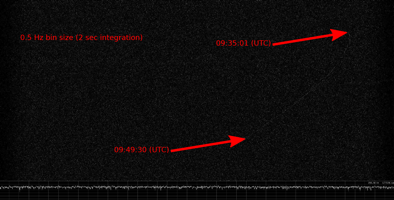Click on the images to view the larger versions
Installing the MSL 70cm Receiver
Suzy Jackson delivered the 70cm MSL receiver and with Ken Reeves, Tim Ruckley and John Sarkissian the receiver was installed in the focus cabin on the morning of Tuesday, 31 July.
Throughout the day, Brett Preisig, Suzy Jackson, Ettore Carretti and Stacy Mader tested and prepared the receiver for the UHF MER test transmission scheduled for later that evening.
Tracking MER Opportunity on Mars
On a clear, moonlit night, the Parkes telescope tracked MER Opportunity. Mars was the bottom of the triangular grouping of bright stars above the dish. The others were Saturn (on the right) and Spica (above Mars).
In the control room waiting for the UHF signal to appear
The MER Opportunity UHF beacon was sequenced to be switched on during the Parkes view period. Right on schedule at 7:35 PM (AEST) - 09:35 UTC - the signal was detected and remained on for the expected 15 minutes or so. Sami Asmar checked out the Radio Science Receiver (RSR) prior to the signal reception and confirmed that all was ready. Stephan Esterhuizen, was able to pull the data from the Parkes RSR and process it at JPL. They remained in telephone contact throughout the short track. The Parkes staff; Brett Preisig, Ettore Carretti, Stacy Mader, Suzy Jackson and John Sarkissian; ensured that the Parkes equipment and tracking software operated correctly.
The test was a success and it confirmed that the Parkes receiver and equipment setups were operating as expected. It gave us confidence that we could detect the feeble UHF signal from MSL (directly from Earth) on the following Monday afternoon.
Success! The Opportunity UHF beacon was clearly Doppler shifted and was on for the expected 15 minutes.

We're ready.